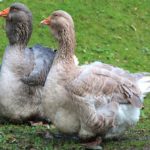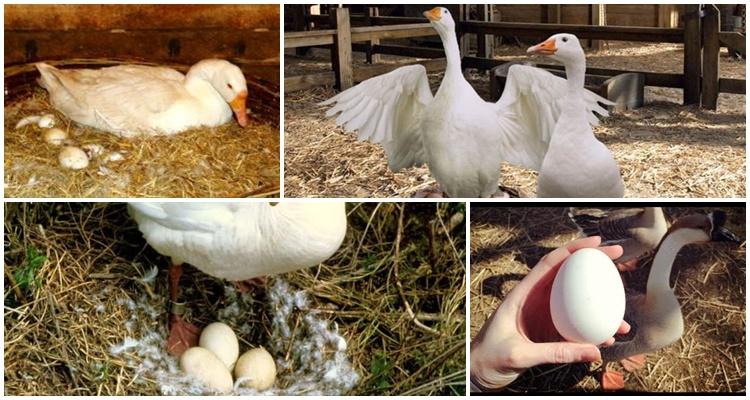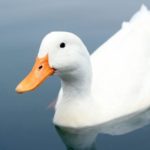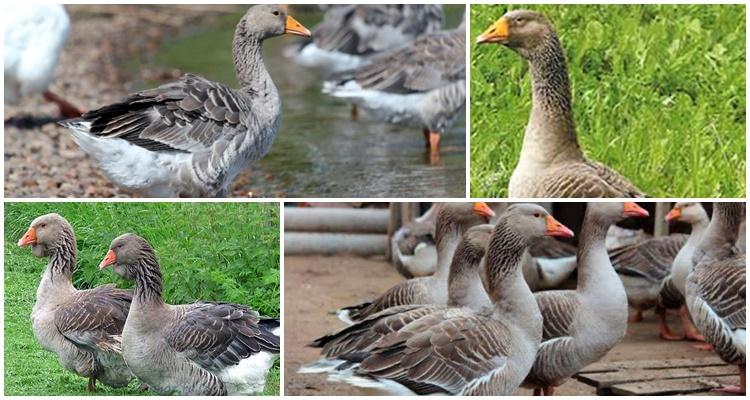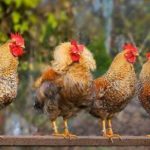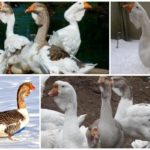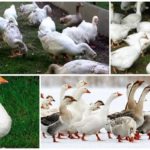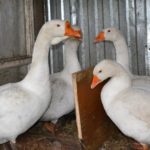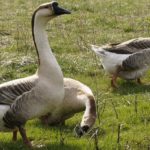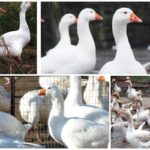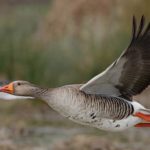There are many goose breeds, and they are all divided into several areas. Geese are raised not only for meat and eggs; there are decorative and fighting breeds that have a specific purpose. Let's look at examples of different breeds of geese that are considered the best for home breeding, their characteristics, external and productive characteristics.
Meat geese
To be raised for meat, breeds are selected whose main characteristics are early maturity, rapid weight gain, large size and disease resistance.
The following breeds can be bred at home:
- A white-fronted goose weighs 3.6-4 kg at 3 months; the birds have strong immunity and do not require special care. However, white-fronted geese are not yet very common, so it is difficult to find purebred representatives.
- The Kuban breed weighs 4 kg at 2 months, and 5 kg or more at 2.5 months. Geese begin to lay eggs at 8-9 months and lay 8.5 dozen eggs per year. Representatives of the Kuban type adapt well to difficult weather conditions and are resistant to diseases.
- Tula geese They weigh impressively: gander - 9 kg, goose - 7-8 kg. These are early maturing birds; by the 55th day of life they can weigh 5-6 kg, and fattening is carried out on standard feed. Resistant to cold and disease. However, they lay few eggs - only 2.5 dozen per season. The survival rate of goslings is 90%.
- Demidov geese grow quickly, by 8-9 months they gain weight of 7-8 kg, but by 2.5 months they can weigh 4-5 kg, at this age they can be slaughtered.
- The Toulouse breed is considered promising for home breeding. Geese meat is tasty; an adult bird weighs 9-10 kg. But by the age of 2 months, the goslings gain weight of 5.5-6 kg. Representatives of this goose species are used as improvers.
Meat and broiler geese fed with nutritious mash or mixed feed and kept in the minimum permissible area. Because of this, they quickly gain weight.
Types of egg direction
There are not so many egg-laying goose species; mainly, selection is carried out for meat. Geese do not produce eggs all year round, but seasonally, which is considered normal. But some varieties are still bred to produce goose eggs, which are not inferior in taste and nutrition to chicken eggs.
Kuban geese can lay up to 80 eggs, Chinese - 70 eggs. Lindovsky geese They begin to lay eggs at 5-6 months and lay 5 dozen eggs during the laying period. Geese of the large gray breed can produce 40 pcs. medium weight eggs. Females of the Italian breed lay 4-5 dozen eggs, egg laying begins at 8 months of age.
Egg-laying varieties of geese are raised under the same conditions as meat-bearing ones. Of course, goose egg production cannot be compared with chicken, but still the brightest representatives of this trend can be kept in the household to produce egg products.
Decorative birds
There are also decorative varieties of geese that have an unusual and attractive appearance. Decoration is achieved through the bright color of the plumage or its special structure. For example, curly-haired geese are standard white in color, but have curly feathers, which is why the breed got its name.
Decorative geese look elegant, they have soft feathers and a calm character, which is why they are bred to decorate the site. But nothing prevents you from receiving meat and eggs from them. Bird size and egg production are average.
When breeding decorative geese, it is important to comply with the conditions of detention - the room, bedding and walking must be clean so that the feathers of the birds also remain clean. Only with neat, well-groomed feathers will decorative birds look attractive.
Fighting geese
In Russia, breeds have been developed whose males are used for goose fighting. Representatives of the breeds have a large body, strong wings, and a specially shaped beak that allows them to capture the wings of an opponent.Geese have an aggressive, pugnacious character. Fighting geese are hardy, unpretentious in keeping, resistant to disease, and can walk in the fresh air even in the cold season.
The most famous of the fighting breeds is the Tula. The birds' build is well suited for fighting, but they grow slowly, development ends only by 2 years, and their weight reaches 5-6 kg. Tula geese, based on the shape of their beaks, are divided into 3 intra-breed types: rogal (with a concave beak), straight-nosed and steep-nosed. Pure lines are popular in the breed, which produce elite breeding material and young stock.
Other fighting breeds include the Arzamas and Gorkovka. They have a different origin than the Tula ones, but in terms of fighting characteristics they are similar. These birds can also be raised for meat, and not kept only for their intended purpose.
The best breeds for home breeding
Poultry farmers who raise geese consider the best varieties to be those whose representatives have a large body and grow quickly. They can be raised as broilers. Goslings of the main meat breeds can weigh almost 4 kg after 2 months, which is considered sufficient weight for slaughter. But if the population is left to grow further, the birds will become larger and fatter. Adults are larger and more massive than young animals. But in the household, only breeding ganders and geese survive to adulthood.
Meat varieties are characterized by such a characteristic as low feed conversion, that is, a small amount of food is spent per 1 kg of gain.
In the group of meat varieties, light and heavy breeds are distinguished. Among the light ones one can note Romny, Chinese, among the heavy ones - Toulouse and Kholmogory, Adler and Rhine.Those who want to get not only meat but also eggs from geese should pay attention to meat-egg breeds. For home cultivation, we can recommend Kuban, large gray, Rhine, and Landish.
But there are other breeds that are suitable for keeping and breeding in private households. When choosing, you need to pay attention to resistance to common diseases and climatic conditions of the area. After all, a lot depends on how the birds feel and their state of health.
Geese are not difficult to raise; they feed on plant foods, mainly grass. This significantly reduces the cost of feeding them and makes the products profitable. You only need to spend money on the purchase of grain, feed, root crops and vegetables.
Geese breeds differ in characteristics, performance and appearance. You can choose any of them for home breeding, the characteristics of which are most liked by the poultry farmer. If you need to get meat, then you need to choose from meat varieties; if you also want to get eggs, you should opt for the meat-egg direction.

